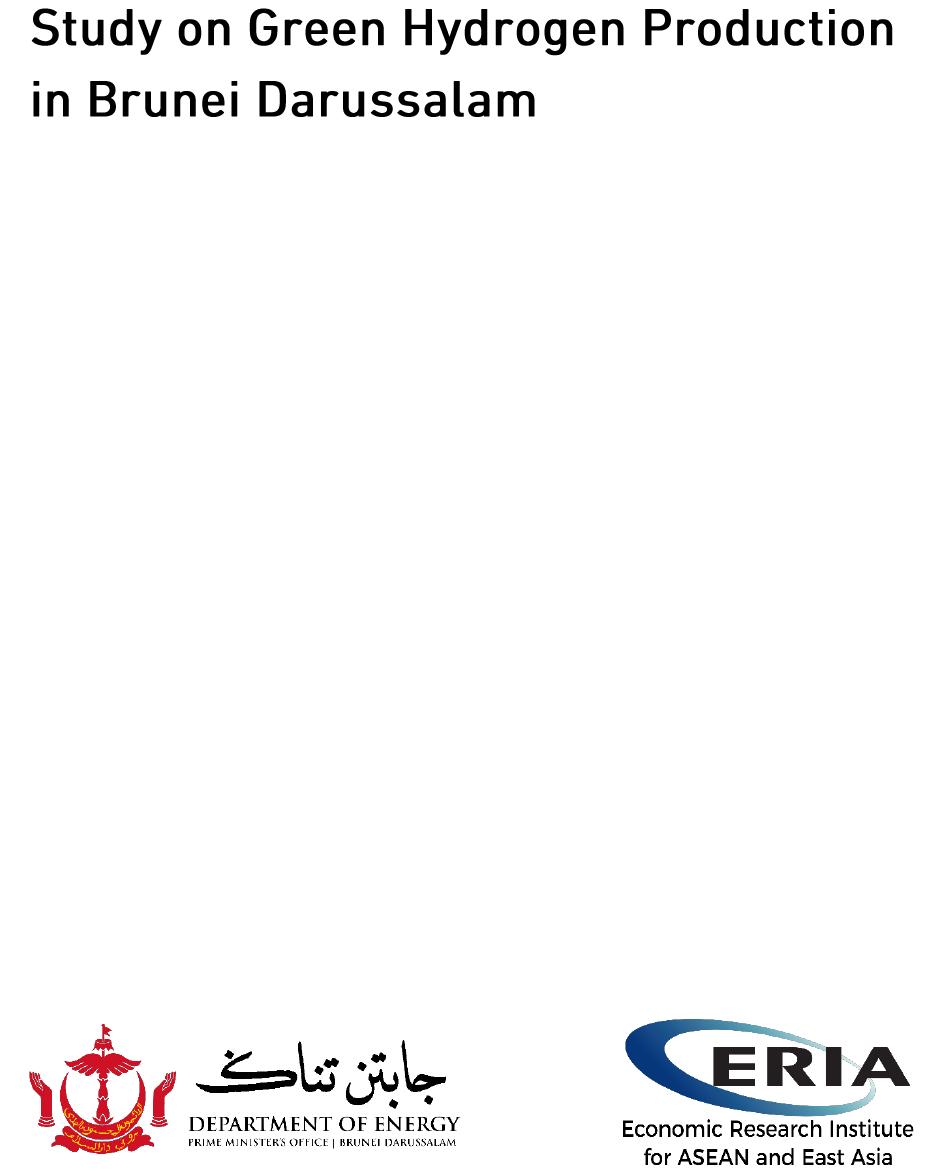ERIAResearchProjectReportFY2023,No.12DepartmentofEnergy,PrimeMinister’sOffice,BruneiDarussalamWithSupportfromEconomicResearchInstituteforASEANandEastAsiaStudyonGreenHydrogenProductioninBruneiDarussalamEconomicResearchInstituteforASEANandEastAsia(ERIA)SentralSenayanII6thFloorJalanAsiaAfrikaNo.8,GeloraBungKarnoSenayan,JakartaPusat12710Indonesia©EconomicResearchInstituteforASEANandEastAsia,2023ERIAResearchProjectReportFY2023No.12PublishedinSeptember2023Allrightsreserved.Nopartofthispublicationmaybereproduced,storedinaretrievalsystem,ortransmittedinanyformbyanymeanselectronicormechanicalwithoutpriorwrittennoticetoandpermissionfromERIA.Thefindings,interpretations,conclusions,andviewsexpressedintheirrespectivechaptersareentirelythoseoftheauthor/sanddonotreflecttheviewsandpoliciesoftheEconomicResearchInstituteforASEANandEastAsia,itsGoverningBoard,AcademicAdvisoryCouncil,ortheinstitutionsandgovernmentstheyrepresent.Anyerrorincontentorcitationintherespectivechaptersisthesoleresponsibilityoftheauthor/s.Materialinthispublicationmaybefreelyquotedorreprintedwithproperacknowledgement.iiPrefaceBruneiDarussalamisfamousforproducingoilandnaturalgas,whicharemainlyexportedtoneighbouringcountriesaswellasJapanandtheRepublicofKorea.Naturalgasisdefinedasatransitionfuel,suchascoaltogascurrently,andthusBruneiwillbeabletoproduceandexportnaturalgascontinuouslyinthecomingdecades.However,naturalgasemitscarbondioxide(CO2)amountingtohalfthatofcoal,soafter2040,gaswillbephasedoutoftheenergymarketinAsiaduetotheregionbecomingcarbonneutral.Inthisregard,hydrogenisnowbeinghighlightedasacombustiblefuellikenaturalgas,butwhichhasnoCO2emissions.Therearetwotypesofhydrogen,bluehydrogenandgreenhydrogen.Bluehydrogenisproducedfromfossilfuels,suchascoalandgas,withcarboncaptureandstoragetoreduceCO2emissions.Ontheotherhand,greenhydrogenisproducedbyapplyingelectrolysistechnologyusingelectricityfromrenewablepowersources,suchassolarphotovoltaic(PV).Bruneiisrichinnaturalgasresourcessoitcanproducelotsofbluehydrogen.However,thecountryhaslimitedrenewableenergyresources,andonlysolarPVisavailableforproducinggreenhydrogenbyapplyingelectrolysistechnology.Nonetheless,Bruneipaysattentiontothemaintenanceofitsgreenareas(tropicalrainforests),andwhilstpotentialareastosetupsolarPVarelimited,theyincludebaregroundwithouttrees,reservoirs,rivers,andtheseainBruneiBay.Consequently,floatingtypesolarPVcanbeexpectedtobeinstalledinthecountry.BasedonelectricitygenerationbysolarPVsystems,thisprojectforecaststhepotentialproductionofgreenhydrogeninBrunei.Comparinghydrogendemandbothinsideandoutsidethecountry,greenhydrogenproductionwillbeinsufficient,andthusbluehydrogenwillalsobeneeded.Hydrogenwillbeastrategicfuel,similartonaturalgas,andthisreportprovidesthoughtsonhydrogenproductionpoliciesinBrunei.ShigeruKimuraSpecialAdvisortothePresidentonEnergyAffairsEconomicResearchInstituteforASEANandEastAsiaiiiAcknowledgementsThisreportwasdevelopedbyajointworkinggroupconsistingoftheBruneiDarussalamteamandtheERIAteam.TheBruneiDarussalamteamconsistedofstaffoftheDepartmentofEnergy,PrimeMinister’sOffice,BruneiDarussalam,whocamefromtheEnergyTransitionDivisionandEnergyPolicyandStrategyDivision.TheERIAteamconsistedofresearchersfromtheEnergyUnitofERIAandahydrogenexpertfromtheChiyodaCorporation.Wewouldliketoacknowledgethemembersoftheworkinggroupfortheirexcellentworkandcontribution.SpecialacknowledgementisalsogiventoMr.AwangHajiMohdZakibinHajiHassanolAs'Shari,DirectoroftheEnergyStakeholders’ManagementDivision,DepartmentofEnergy,PrimeMinister’sOffice,BruneiDarussalam,andMr.ShigeruKimura,SpecialAdvisortothePresidentonEnergyAffairs,ERIA,fortheirexcellentleadershipofthisproject.YMPengiranHajiJamraWeiraBinPengiranHajiPetraActingPermanentSecretary(Energy)PrimeMinister’sOffice,BruneiDarussalamivTableofContentsPrefaceiiiAcknowledgementsivListofProjectMembersviListofFiguresviiListofTablesixListofAbbreviationsandAcronymsxExecutiveSummaryxiiChapter1Introduction1Chapter2ForecastforPotentialSolarPVCapacityinBruneiDarussalam2Chapter3ForecastforPotentialGreenHydrogenProductioninBrunei13DarussalamChapter4PotentialHydrogenDemandinBruneiDarussalam17Chapter5EconomicImpactofGreenHydrogenProduction31Chapter6ConclusionsandRecommendations40References42Appendices43vListofProjectMembersDepartmentofEnergy,PrimeMinister’sOffice,BruneiDarussalamTeamMohammadIzwanbinHajiTarip,HeadofEnergy,TransitionDivisionAwangHajiMohdZakibinHajiHassanolAs'Shari,ActingDirector,EnergyStakeholderManagementDivisionIzmaRahemZukhairribinAbdulZani,DeputyDirector,EnergyStakeholderManagementDivisionNurulHadinahbintiYahaya,EnergyTransitionDivisionMuhammadHasburRahmanbinYahaya,EnergyTransitionDivisionShaikhMohamadFaizBinShaikhHjFadilah,EnergyPolicyandStrategyDivisionDkAkmalZawanahBintiPgDrHjAbdRazak,EnergyStakeholderManagementDivisionERIAStudyTeamShigeruKimura,SpecialAdvisertothePresidentonEnergyAffairs,ERIAAlloysiusJokoPurwanto,EnergyEconomist,EnergyUnit,ERIACitraEndahNurSetyawati,ResearchAssociate,EnergyUnit,ERIAOsamuIkeda,ChiyodaCorporationTakeshiMiyasugi,ChiyodaCorporationRyujiTsukada,ChiyodaCorporationviListofFiguresFigure2.1YamakuraFloatingSolarPowerGenerationStation,ChibaPrefecture,2JapanFigure2.2TengehFloatingSolarFarminSingapore3Figure2.3OffshoreFloatingSolarFarminJohor,Malaysia4Figure2.4CandidateSitesforPVinBruneiDarussalam8Figure2.5ToyoakeFloatingMegaSolarPowerPlant9Figure2.6OperationalDataforToyoakeFSPV,202210Figure2.7IrradianceLevelsinBruneiDarussalam11Figure4.1BruneiDarussalam’sEstimatedPowerGenerationOutputwith16HydrogenCofiring–BAUScenarioFigure4.2BruneiDarussalam’sEstimatedPowerGenerationOutputwith19HydrogenCofiring–APSFigure4.3ASEAN’sEstimatedPowerGenerationOutputwithHydrogenCofiring20–BAUScenarioFigure4.4ASEAN’sEstimatedPowerGenerationOutputwithHydrogenCofiring20–APSScenarioFigure4.5ASEAN’sEstimatedHydrogenDemandforCofiringinPower21Generation–BAUScenarioFigure4.6ASEAN’sEstimatedHydrogenDemandforCofiringinPower22Generation–APSScenarioFigure4.7BruneiDarussalam’sDemandforHydrogeninTermsofEnergyin23ThreeHydrogen-poweredFuelCellVehicleScenariosFigure4.8BruneiDarussalam’sEstimatedHydrogenDemandfromtheRoad24TransportSectorFigure4.9ASEAN’sEstimatedHydrogenDemandfromtheRoadTransport25Sector–BAUScenarioFigure4.10ASEAN’sEstimatedHydrogenDemandfromtheRoadTransport26Sector–APSFigure4.11BruneiDarussalam’sEstimatedHydrogenDemandfromtheIndustry28Sectors–FourScenariosFigure5.1SupplyandDemandofCrudeOilinBruneiDarussalam31Figure5.2SupplyandDemandofPetroleumProductsinBruneiDarussalam32viiFigure5.3SupplyandDemandofNaturalGasinBruneiDarussalam33Figure5.4RelationbetweenNaturalGasExportsandEconomicGrowth34Figure5.5GDPComponentsofBruneiDarussalam35Figure5.6SimplifiedEconomicStructureofaCountry36viiiListofTablesTable2.1CurrentStateandPlansforGlobalFSPVInstallation5Table2.2CandidateSitesforPVinBruneiDarussalam8Table2.3ComparisonofClimaticDataforBruneiDarussalamandToyoake10Table2.4CapacityFactoratToyoake11Table3.1ComparisonbetweenALKandPEM13Table3.2PVPotentialandH2ProductioninBruneiDarussalam14Table4.1BruneiDarussalam’sEstimatedHydrogenDemandbyIndustrySector29–FourScenariosixACListofAbbreviationsandAcronymsAEMALKAlternatingCurrentAMSAnionExchangeMembraneAPECAlkalineElectrolyserAPSASEANMemberStateASEANAsia-PacificEconomicCooperationBAUAlternativePolicyScenarioBEVAssociationofSoutheastAsianNationsBFIBusinessasUsualCCSBatteryElectricVehicleCECEPBruneiFertilizerIndustryCO2CarbonCaptureStorageCRChinaEnergyConservationandEnvironmentalProtectionDCCarbonDioxideDNVCarbonRecyclingDOEDirectCurrentEASDetNorskeVeritasEEDepartmentofEnergyESMAPEastAsiaSummitEVEnergyEfficiencyFCEnergySectorManagementAssistanceProgramFCEVElectricVehicleFSPVFuelCellGCLFuelCellElectricVehicleGDPFloatingSolarPVGJGoldenConcordLtd.GWGrossDomesticProductGigajouleGigawattxGWhGigawattHourH2HydrogenHaHectareINDCIntendedNationallyDeterminedContributionIRENAInternationalRenewableEnergyAgencyKtoeKilotonnesofOilEquivalentKtpaKilotonnesperAnnumKWKilowattKWhKilowattHourMJMegajouleMTMegatonnesMWeMegawattElectricityMWhMegawattHourMWpMegawattPeakNDCNationallyDeterminedContributionNELNationalEnergyLaboratoryNm3NormalCubicMetrePEMPolymerElectrolyteMembranePPPowerPlantPVPhotovoltaicRERenewableEnergySERISSolarEnergyResearchInstituteofSingaporeSOECSolidOxideElectrolyserCellSTEPSStatedPoliciesScenarioTWTerawattUKUnitedKingdomUSUnitedStatesWWattxiExecutiveSummaryBruneiDarussalamisrichinoilandgasproduction,butforrenewableenergy,onlysolarphotovoltaic(PV)isavailableduetothestrongsunshine.ThelandareaofBruneiisphysicallyandenvironmentallylimitedforsettingupsolarPVsystems,butpotentialareascomprisebareground,reservoirs,rivers,lakes,andBruneiBay.Accordingtothisstudy,atotalcapacityof1,030megawatts(MW)offloatingsolarPV(FSPV)isavailabletobesetupatreservoirs,rivers,andlakesinBrunei.Inaddition,atotalof700MWofFSPVisavailableinBruneiBayandatotalof424MWofsolarPVisavailableusingbareground.Thus,thetotalinstalledcapacityforsolarPVsystemsisestimatedtobe2,154MWinthecountry.Ifweassumea17%capacityfactorforland-basedsolarPVsystemsand19%forFSPV,thetotalpowergenerationbysolarPVsystemsisestimatedat3,510GWhperyear.IfweassumeaunitcapitalcostofsolarPVandFSPVofUS$800perKW,thepowergenerationcostisestimatedataboutUS$0.0624perkWh.Whenweuse3,510GWhattheelectrolyserfacilitiesforproducinghydrogen,theamountisestimatedat65.7kilotonnesperyearapplyingpolymerelectrolytemembrane(PEM)technology,anditshydrogenproductionefficiencyisassumedat4.77kWh/Nm3-H2.IfweassumeaunitcapitalcostoftheelectrolyserfacilitiesofUS$1,050perKWe,thetotalcapitalcostoftheelectrolyserisestimatedatUS$429million,andthehydrogenproductioncostisalsoestimatedasUS$4.258perkg-H2.Hydrogencombustslikefossilfuelsbutdoesnotemitcarbondioxide,sohydrogencanbesubstitutedforoilandgasconsumptionacrosssectors.Currently,oilandgasarelargelyconsumedinthefinalenergyconsumptionsector,whichconsistsoftheindustry,transport,residentialandcommercial,andpowergenerationsectors.Accordingtothisstudy,hydrogendemandforthepowergenerationsectorintheAssociationofSoutheastAsianNations(ASEAN)regionisforecastedat70milliontonnes,1.3milliontonnesfortheroadtransportsector,and11.3milliontonnesfortheindustrysectorin2050.Sofar,hydrogenhasnotbeenusedforenergy,soascenarioapproachisapplied:10%in2030,50%in2040,and100%in2050asthehydrogencofiringratioatgaspowerplants,and30%in2050astheFCEVratiotothetotalvehiclestockandthereplacementoffossilfuelsconsumedforheatdemand,suchasforboilersandfurnacesintheindustrysector.Asaresult,greenhydrogenproductioninBruneiisestimatedat73.4kilotonnesperyear.Ontheotherhand,hydrogendemandintheASEANregion,includingBrunei,isforecastedtobemorethan80milliontonnesperyearby2050.Thus,theamountofgreenhydrogenwillnotbeabletomeethydrogendemand,sobluehydrogenproducedfromnaturalgaswithcarboncaptureandstoragewillstillbeanimportantoptionforBrunei.TheinvestmentamountforsolarPVsystems,mainlyFSPVandwaterelectrolysis,isestimatedataboutUS$2,152millionandissignificantcomparedtotheannualgrossfixedcapitalformationofaboutUS$5,000million.Thus,Bruneicanexpectalargeeconomicimpactwiththeoperationofbothfacilities.However,thereisstillanissueofthehighergreenhydrogenproductioncostatUS$3.5–US$5.2/kg-H2accordingtothisstudy.TheglobaltargetofthehydrogensupplycostwillbeUS$1–US$2/kg-H2,thusweneedtoinvestigatemeasuresforhydrogensupplycostreduction,suchasfurthercostreductionsinsolarPVsystemsandimprovementsinhydrogenxiiproductionefficiencybyapplyingelectrolysistechnology.IfBruneiexports5milliontonnesofhydrogen,includingbluehydrogen,thiswillamounttoaroundUS$10billion,almostthesameastheexportvalueforBruneiin2019.Thus,theproductionofbluehydrogenisindispensableforBrunei.Inaddition,BruneiwillbeabletoimpotelectricityfromSarawakprovince,Malaysia,whichwillbegeneratedbyhydropowerplants.IfBruneiimports1GWelectricityfromSarawakprovince,Bruneicanproducegreenhydrogenaround65kiloton/year,ifweassumecapacityfactorofthehydropowerat40%.ItissignificantandelectricityimportfromSarawakprovincewillbeaveryimportantoptionforBruneitoincreasegreenhydrogenproduction.xiiiChapter1IntroductionHydrogenisapromisingfuelandtechnologyforbecomingcarbonneutraltowards2050or2060,andBruneiDarussalamhassignificantpotentialforproducingblueandgreenhydrogen.Bluehydrogenisproducedfromnaturalgasorasaby-productoftheliquefiednaturalgasproductionprocess.Greenhydrogenisproducedfromelectrolysisfacilitiesusingelectricityfromrenewableenergy,suchashydropower,geothermalpower,biomass,solar,andwind.However,Bruneionlyhassolarphotovoltaic(PV)potentialduetoitsgeographicalandclimateconditions.Thus,thisprojectfirstlysurveyssolarPVpotentialcapacityinBrunei,focusingonwatersurfacesandthebareground.Whenweconductthesurveyonland,weneedtopayattentiontoforestareas.Secondly,basedonthesolarPVpotentialcapacityandassumedcapacityfactorofthesolarPVsystem,theamountofelectricitygenerationbythesolarPVsystemisestimated.Thirdly,thisprojectestimateshydrogenproductionamountsbasedonthepowergenerationbythesolarPVsystemreferringtoexistinghydrogenproductionefficiencies,suchastheInternationalRenewableEnergyAgency(IRENA).Thisprojectalsoforecastshydrogendemandby2040inandoutofBruneibysector–power,industry,andtransport.TheexporttargetsofBruneiareotherAssociationofSoutheastAsianNations(ASEAN)countries,suchasIndonesia,Malaysia,thePhilippines,Singapore,andThailand.IfgreenhydrogenproductiondoesnotmeetthehydrogendemandintheASEANregion,BruneiwillneedtoproducebluehydrogentosupplytotheASEANcountries.Inaddition,thisprojectstudieseconomicanalysisofthegreenhydrogenbusinessforBrunei.Thisstudyfocusesonareviewofoilandgashistoricalproduction,estimationofcapitalinvestmentofthesolarPVsystemandelectrolyserfacilities,theeconomicimpactofthecapitalinvestmentonBrunei’seconomy,andthepossibilityofcleanhydrogenforreplacingoilandgasexports.NotonlyBruneiDarussalambutalsoothercountries,suchasMiddleEasterncountries,India,andAustralia,willproducecleanhydrogenandexportittoAsiancountries,soBruneiwillfacehardcompetitionregardingexportsofcleanhydrogen.OneadvantageforBruneiDarussalamisitslocation,asitisclosertoASEANandEastAsiancountriesthanMiddleEasterncountries,India,andAustralia.Thus,BruneiwillplayakeyroleinthecleanhydrogensupplynetworkintheEastAsiaSummitregion.1Chapter2ForecastforPotentialSolarPVCapacityinBruneiDarussalam1.ExamplesofFloatingSolarPVSystemsThefollowingareexamplesofexistingfloatingsolarPV(FSPV)systems:•YamakuraFloatingSolarPowerGenerationStation,ChibaPrefecture,Japan•Singapore’sfloatingsolarfarmontheTengehReservoir•Woodlands,StraitsofJohor(1)YamakuraFloatingSolarPowerGenerationStation,ChibaPrefecture,Japan,2018•Polycrystalsiliconpanel:305watts(W)/panelx44,898=13.7megawattselectric(Mwe)(11.5MWetransmitted)•Annualoutput:16,100,000kilowatt-hours(kWh)(capacityfactor16%)•Surfacearea:18hectares(ha)(watersurfacearea:61ha)Figure2.1.YamakuraFloatingSolarPowerGenerationStation,ChibaPrefecture,JapanSource:NewsreleaseofKyocera,1October2021.Kyocera’s13.7MWefloatingsolarpanelsweredamagedby200kilometresperhour(km/h)windsthatTyphoonFaxaibroughttothecoastalcityofChibain2019.Afteraround2yearsof2remedialwork,theFSPVsystemrestartedoperationsin2021withsixseparatedsolarpanelislandsasshowninFigure2.1.(2)Singapore’sfloatingsolarfarmontheTengehReservoir,2021•Madeupof122,000solarpanelsspanning45ha•Solarpanelsspreadacross10solarpanelislands•60megawatt(MW)peaksolarPV⇒60,000/122=490W/panelFigure2.2.TengehFloatingSolarFarminSingaporeSource:SingaporeInternationalWaterWeek(n.d.)SembcorpTengehFloatingSolarFarm.https://www.siww.com.sg/spotlight-2023/programme/technical-site-visits/sembcorp-tengeh-floating-solar-farmThesolarfarmwasdeployedaspartofSingapore'sgoaltoquadruplesolarenergycapabilitiesby2025.Thefarmisdesigned,built,ownedandoperatedbySembcorpFloatingSolarSingaporeinpartnershipwiththePublicUtilitiesBoard,whichregulatesandoverseesthewatersupplysysteminSingapore.(3)Woodlands,StraitsofJohor,2021•Powergeneration:5MWe•Configurationoffarm:13,312panels,40invertersand>30,000floats•Annualoutput:6,000MWh(capacityfactor14%)Thesolarfarmconsistsofelectricalpanels,acontrolsystem,22-kilovolt(kV)transformers,andalandingpointforthesubseacabletransmittinggeneratedpowertothenationalgrid.ThefloatingPVsystemisdesignedwitharobustconstanttensionmooringsystem.3Figure2.3.OffshoreFloatingSolarFarminJohor,MalaysiaSource:Hill,J.(2021),SunseapCompletesOffshoreFloatingSolarFarminStraitsofJohor.https://reneweconomy.com.au/sunseap-completes-offshore-floating-solar-farm-in-straits-of-johor/2.CurrentStateandPlansforGlobalFSPVInstallationTable2.1showsthecurrentconstructionrecordsandplansforFSPVsof5megawatt-peaks(MWp)ormore.ThelargestoftheseisplannedforMadhyaPradeshinIndia,whichisexpectedtostartgenerating600MWpin2022–2023.ChinaaccountsforthemajorityofFSPVsof100MWpormore,andthesearecharacterisedbythefactthatFSPVsareinstalledinpondsmadefromabandonedmines.AscanbeseenfromTable2.1,FSPVsaremainlyinstalledininlandwaterbodies.Thisisbecausetheenvironmentalloadgiventothefloatingstructureismuchmoresevereinseasthanininlandwaters.AsforoffshoreFSPV,inadditiontothe5MWpinstalledintheStraitsofJohor,asmalloffshoreunitcalledSolarSeahasbeenintroducedintheMaldives.Theunitissaidtobeabletowithstandwavesofupto1.5mhighandwindsof10km/h,aswellasstrongultravioletandhumidity.InJapan,therearenoFSPVsinstalledontheseayet,butademonstrationtestoffloatingsolarpowergenerationisplannedastheTokyoBayeSGproject,withanimplementationperiodfrom2022to2024.Thedetailsoftheimplementationprocedureareasfollows.•Designandinstallationofmultiplefloatingsystems•Designandinstallationoffloatingstructuresandmooringsystemsforoffshoreuse•Verificationoftheeffectsofsaltdamageonelectricalequipment•Comparativeverificationofthepowergenerationnumberofdifferenttypesoffloatingsystems,suchasoffshoreandonshore4Table2.1.CurrentStateandPlansforGlobalFSPVInstallationCategorySizeWaterBodyandNearestCityCountryCity/ProvinceFloatingSystemSupplier(s)(andCompletionL&D(kWp)IndiaKhandwaDistrictsubcontractor,ifpossible)Year600,000MadhyaPradesh,reservoirformedbyChinaDezhou-theOmkareshwarDamChinaAnhuiProvince2023L&D320,000DezhouDingzhuangFloatingSolarFarmBeijingElectricCompanyHuanengPower2022reservoirinShandongInternational2018MS150,000Coalminingsubsidencearea,HuainanBeijingNorttMan,Zhongya,HefeiJintechCity(FengtaiGuqiao-Sungrow)NewEnergyCo.Ltd.,AnhuiZNZCNew2018EnergyCo.Ltd.,CJInstituteChinaMS150,000Coalminingsubsidencearea,HuainanChinaAnhuiProvinceSungrowFloating(AnhuiZNZCNewEnergy2018City(Panji-ChinaThreeGorgesNewChinaAnhuiProvinceTechnologyCo.Ltd.)MS130,000Energy)2017Yingshangcoalminingsubsidencearea,AnhuiZNZCNewEnergyTechnologyCo.2018(Liuzhuangmine-TrinaSolar)Ltd.,ShanghaiQihuaWharfEngineeringCo.2018Ltd.,etc.2021MS102,000Coalminingsubsidencearea,HuainanChinaAnhuiProvinceSungrowFloating(AnhuiZNZCNewEnergy2017City(FengtaiXinji)TechnologyCo.Ltd)2021MS100,000Coalminingsubsidencearea,JiningCityChinaShandongProvinceSungrowFloating2017MineLake,nearHuaibei(CECEP)ChinaAnhuiProvinceCiel&TerreInternational2017L&D70,005TengehReservoir,Southwest,SingaporeSingaporeSembcorpIndustriesCoalminingsubsidencearea,JiningCityChina-SungrowFloatingL&D60,000(ShandonWeishan)ShandongProvinceSirindhorndam,UbonRatchathaniThailand-MS50,000RenloucoalmineinHaibeiCity(TrinaChina-ShanghaiQihuaWharfEngineeringCo.Ltd.,Solar)AnhuiProvinceetc.L&D45,000Coalminingsubsidencearea,HuainanChinaSungrowFloatingCity(20+20Panji)AnhuiProvinceMS40,000MS40,0005Table2.1.CurrentStateandPlansforGlobalFSPVInstallation(continued)CategorySizeWaterbodyandnearestcityCountryCity/ProvinceFloatingsystemsupplier(s)(andCompletion(kWp)ChinaAnhuiProvincesubcontractor,ifpossible)yearL&D32,686MineLake(GoldenConcordLtd(GCL)ChinaShandongProvinceMS31,000Coalminingsubsidencearea,JiningCityCiel&TerreInternational2018(ShandongWeishan)ChinaAnhuiprovinceSungrowFloating2017MS20,000Coalminingsubsidencearea,HuainanCity(Xinyil)Korea,RepNorthJeollaN/A2016L&D18,700GunsanRetardingBasinofJapanChibaScotraCo.Ltd.2018L&D13,744YamakuraDamReservoirCiel&TerreInternationalOriginal2018,-10,982XuzhouPeiCountryChinaJiangsuProvinceCiel&TerreInternationalmodificationCiel&TerreInternational2021L&D9,087UrayasuIkeJapanChibaN/A2017N/A2018-8,500Wuhu,SanshanChinaAnhuiProvinceCiel&TerreInternational2015TakironEngineeringCo.Ltd.2015L&D8,000LakeinXingtai,LinxiCountryChinaHebeiCiel&TerreInternational2015Ciel&TerreInternational2018L&D7,550UmenokiIrrigationReservoirJapanSaitama2015SunseapGroup2016L&D6,800HiritaniIkeJapanHyogo2021L&D6,776AmineLake,JiningCityChinaShandongProvinceL&D6,338QueenElizabethIIDrinkingWaterUnitedLondonReservoirKingdomSEA5,000StraitsofJohorSingapore-KWp=kilowattpeak,L&D:lake,dam,andwaterreservoir,MS=miningsubsidence,SEA=seaarea.Source:WorldBankGroup,ESMAP,andSERIS(2019),FloatingSolarMarketReport;variouswebsites.63.ProsandConsofFSPVFSPVsystemshavedifferentprosandconsfromthepointsofviewofdesign,installation,andoperation.TheprosandConsofFSPVsystemsarelistedbelow.•ProsofFSPV:(1)Shortenedconstructionperiodasnoneedfordeforestationorgroundpreparation.(2)Maintainingforestsandpreservinglimitedlandforotherpurposes,suchasindustrialneeds.(3)Thecoolingeffectofwaterleadstohigherpowergenerationefficiencycomparedtoground-mountedsolarPVsystems.(4)Theshadingeffectofthepanelshelpstoreduceevaporationandthepresenceofalgaebloomsinwater.•ConsofFSPV:(1)Onboardworkandunderwaterworkarenecessarytoinstallpanelsandstructures.(2)ThecostofbuildingFSPVsismoreexpensivethanground-mountedsolarPV,duetotheneedtobuildfloatingstructures.(3)Shadingeffectofthepanelsleadstoanincreaseinphytoplanktonand,asaresult,waterdegradation.(4)NecessityofFSPVsystemdesignthatdoesnotspoilthescenery.4.SuitableAreaforFSPVInstallationAsuitableareaforinstallinganFSPVsystemonthewatersurfacehastofulfilthefollowingconditions:•Highsolarradiation:Brunei4.00–4.99kWh/m2/day•Environment(1)NoshadingeffectonFSPVmodules(2)Waterdepth:<10m(3)Stablewatersurface(4)Normalwindspeed:<34m/s(5)Fewwater-levelfluctuations(6)Nosevereweatherconditions•Gridconnection(1)Connectingfacilitycanbeeasilyinstallednearby(2)Underwaterorfloatingcableconnectiontothefacility75.CandidateSitesforPVinBruneiTable2.2andFigure2.4showthecandidatesitesforfloatingPVandground-mountedPV.Table2.2.CandidateSitesforPVinBruneiDarussalamCategorySiteEstimatedEstimatedSourceArea(ha)Capacity(MW)MengkubauDam197125(1)BenutanDam639406(1)UluTutongDam517329(1)KarguDam286170(2)SerasaBay4730(3)BruneiBayBothsidesofTemburongBridge1,000640(3)MuaraBesarIsland4730(3)KgBelimbing3838(1)SungaiTeraban202200(1)BukitPanggal5062(2)Ground-mountedKgTanjungBungar1215(2)KgSeriTanjungBelayang5062(2)KgBelingus38.547(2)Ha=hectare,MW=megawatt.Sources:(1)‘PotentialSitesforSolarInstallationinBruneiDarussalamNov2022DepartmentofEnergy’,presentedat1stWorkingMeetingontheGreenHydrogenProductioninBruneiDarussalam,28November2022.(2)CommunicationswiththeDepartmentofEnergy,PrimeMinister’sOffice,BruneiDarussalam.(3)1stWorkingMeetingontheGreenHydrogenProductioninBruneiDarussalam,28November2022,andsubsequentstudy.Figure2.4.CandidateSitesforPVinBruneiDarussalamSource:Authors.86.CapacityFactorinBrunei6.1.CapacityFactorofFSPVFSPVissaidtohavea5%–10%increaseinpowergenerationefficiencycomparedtoground-mountedPV,asthepaneltemperatureriseissuppressedbythecoolingeffectofthewater.Forthisreason,whensettingthecapacityfactorofFSPVtobeinstalledinBrunei,wereferredtoJapan’sToyoakefloatingmega-solarpowerplant,forwhichtheoperatingdatahavebeenpublished.(1)OutlineofToyoakeFSPV•Location:AichiPrefecture,Japan•InstalledCapacity:1,500kWp•Area/panel:1.9ha/6,720panels•Operation:SinceMarch2017(datafor2022areshowninFigure2.6)Figure2.5.ToyoakeFloatingMegaSolarPowerPlantSource:ToyoakeCityOffice(n.d.).https://www.city.toyoake.lg.jp/4558.htm9Figure2.6.OperationalDataforToyoakeFSPV,2022250,000250200,000200kWh-elec/month150,000150kWh-rad/(m2・month)100,000100kWh-elec/month50,000kWh-rad/m2・month500TOYOAKEFSPVStation(1,500kW)0JanFebMarAprMayJuneJulyAugSeptOctNovDecSource:Authors.(2)ComparisonofclimaticdataonBruneiandToyoakeTable2.3showsdataontemperature,humidity,precipitation,andsolarirradianceforBruneiandToyoake.TheirradiancelevelsinBruneiareshowninFigure2.4.Table2.3.ComparisonofClimaticDataforBruneiDarussalamandToyoakeMayJuneJulyAugustSeptemberTemperature(oC)Brunei28.828.728.027.928.4DarussalamToyoake118.422.326.027.223.7Humidity(%)Brunei7877797876DarussalamToyoake7278817777Precipitation(mm)Brunei156.570.582.5263.5151.5DarussalamToyoake141181173120204SolarIrradiance(kWh/m2/month)Brunei144–152(annualaverage)DarussalamToyoake154148139133126Source:BruneiDarussalam:CommunicationswithDepartmentofEnergy,PrimeMinister’sOffice,BruneiDarussalam;ToyoakeCity(https://www.city.toyoake.lg.jp/).10Figure2.7.IrradianceLevelsinBruneiDarussalam1,750~1,850kWh/m2/year(144~152kWh/m2/month)Source:FeasibilityStudyforAlternativeEnergySourcesforBruneiDarussalam,AReporttotheCentreforStrategicandPolicyStudies,submittedbyPowertech,Canada,2011.(3)EstimationofcapacityfactorofFSPVinBruneiAsshowninTable2.3,Toyoake’sclimateconditionsfromMaytoSeptemberaresimilartothoseofBrunei,sotheactualvaluesofToyoake’scapacityfactor(showninTable2.4)aretakenfortheestimationforBrunei.Table2.4.CapacityFactoratToyoakeMayJuneJulyAugustSeptember15Capacity21211918Factor(%)Source:Authors.Basedontheabove,thecapacityfactorofFSPVinBruneiwassetat19%byadoptingtheaveragevaluefromMaytoSeptemberatToyoake.116.2.CapacityFactorofGround-mountedSolarMordorIntelligence1hasreportedthatBruneihasalargesolarpotentialduetoitsgeographicallocation,withover90%ofthecountryhavingasolarpotentialof1,400–1.600kWh/kWp/year.Fromthefigureof1,400–1.600kWh/kWp/year,acapacityfactorof16%–18%wasderivedforground-mountedsolar,andacapacityfactorof17%wassetforground-mountedsolar.1https://www.mordorintelligence.com/industry-reports/brunei-power-market12Chapter3ForecastforPotentialGreenHydrogenProductioninBruneiDarussalam1.ElectrolysisTechnologiesAnelectrolyserconsistsofanumberofcellsconnectedtogetherwithcommonelectricterminals,i.e.,busbars.Eachcelliscomposedoftwoelectrodes,twoporoustransportlayers,andthebipolarplates.Otherpartsoftheelectrolysersystemincludetransformers,rectifiers,andprocessunits,suchasforwatertreatment,gascooling,gasscrubbing,hydrogen(H2)deoxidising,H2drying,andgascompression/storage.Fourtypesofelectrolysersareunderfocus:alkalineelectrolyser(ALK),polymerelectrolytemembrane(PEM),solidoxideelectrolyticcell(SOEC),andanionexchangemembrane(AEM).Amongstthefourtypes,SOECandAEMarestillinthedevelopmentstages,andALKandPEMarewell-commercialised.Fromtheviewofcostandavailability,ALKismuchsuperiortoPEM,butfromtheviewofflexibilityforintermittentrenewableenergy,PEMisbetterthanALK.Table3.1showsacomparisonofthecommercialisedelectrolysers.Table3.1.ComparisonbetweenALKandPEMTechnologymaturityAlkalineElectrolysis(ALK)PolymerElectrolyteMembraneProductH2purity(PEM)Well-commercialisedResponsiveness/Ramprates>99.95%moduleoutlet(dryCommercialisedOperatingloadrange>99.7%moduleoutlet(drygasElectricityEfficiencygasbasis)4%/sec(0%–100%load)basis)StackDC(kWh/Nm3-H2)10%/sec(0%–100%load)PlantAC(kWh/Nm3-H2)10%–100%Vendors/originalequipment20%–100%manufacturersSource:Authors.3.8–4.63.8–4.44.7–5.64.7–5.6NEL,Thyssenkrupp,AsahiSiemens,NEL,ITMPower,CumminsKasei,SuzhouJungli2.FSPVpotentialandhydrogenproductioninBruneiTable3.2showstheestimatedelectricitycapacityandelectricitygenerationderivedbyusingthecapacityfactorsforinland,offshore,andground-mountedPV.Also,H2productionisestimatedbyusinganelectrolyserefficiencyof4.77kWh/Nm3-H2.13Table3.2.PVPotentialandH2ProductioninBruneiDarussalamCatchmentWaterAverageEstimatedAreaforEstimatedCapacityElectricityEstimatedH2SiteAreaStorageDepthPVElectricityFactorGeneratedProductionTypeAreaCapacityRemarksFloating(ha)(million(m)(ha)(%of(MW)(MW/ha)(%)(MWh/y)(kilotonnes/y)PVm3)catchment)1TasekDam4271.10.268520550.641991,0321.70(2)2Mengkubau1,37016.81.2319714.41260.6419209,8583.93(1)Dam3Benutan2,900561.9363922.04080.6419679,54012.71(1)Lake,Damdams,4UluTutong10,800800.745174.83300.6419549,62810.28(1)andDamreservoir5KarguDam1,43010.70.75286201830.6419304,8605.70(2)6KagoDam---267-1710.6419284,6075.32(1)7Imang1,400100.71188-1200.6419200,3983.75(1)ReservoirSubtotal1,3932,319,92443.401SerasaBay---47-300.641950,0990.94(3)2Bothsides---1,000-6400.64191,065,94619.94(4)ofBruneiTemburongBayBridge3Muara---47-300.641950,0990.94(3)BesarIslandSubtotal7001,166,14421.81Land-1SgAkar---38-381.001756,6281.06(1)based2PekanBelait---56-561.001783,4521.56(1)14CatchmentWaterAverageEstimatedAreaforEstimatedCapacityElectricityEstimatedH2SiteAreaStorageDepthPVElectricityFactorGeneratedProductionTypeAreaCapacityRemarks(ha)(million(m)(ha)(%of(MW)(MW/ha)(%)(MWh/y)(kilotonnes/y)m3)catchment)Ground-3Sungai---202-2000.9917298,0445.58(1)mountedTerabanPVSubtotal294438,1258.20Grandtotal2,3873,924,19373.411ThevaluesoftheestimatedareaforPVandestimatedelectricitycapacity(MW)areusedfromthereport‘DOEPotentialSitesforSolarInstallationinBruneiDarussalam,November2022’.2ThevaluesoftheestimatedareaforPVaresetto20%ofthecatchmentarea,andthevaluesoftheestimatedelectricitycapacityarecalculatedusing0.64MW/ha.3ThemaximumvalueoftheFSPVinstalledintheseaareais5MWintheJohorStrait,Singapore,butinthestudy,itwassetto30MWwhichis6timesthat.4PVpanelsshallbeinstalledinanareaof500minwidthand10,000minlengthonbothsidesoftheTemburongBridge.Source:Authors.153.CalculationofGreenHydrogenCostThegreenhydrogencostiscalculatedfromthePVpotential(estimatedelectricitycapacity),whichissummarisedinTable3.2withthefollowingprocedure.•Electricitygenerated(1)PVpotential:2,154MW(2)CapacityfactorofPV:17%(land-based)–19%(watersurface)(3)Electricitygenerated:3,510,832MWh/y(4)1,730MWx8,760hrs/yx0.19:2,879,412MWh/y(watersurface)(5)424MWx8,760hrs/yx0.17:631,420MWh/y(land-based)•H2production:4.77kWh/Nm3-H2(1)PEMelectricityefficiency(2)H2production:a.3,510,832MWh/y/4.77kWh/Nm3:736MNm3/yb.736MNm3/y/11.2Nm3/kg:65.7kilotonnes/y•Calculationofgreenhydrogencost(1)Renewableelectricitycost:0.050.07US$/kWh4.6–5.2US$/kg-H2(2)Greenhydrogencost:3.5–4.14.Conclusion•GreenhydrogenproducedfromelectrolysistechnologiesusingrenewableelectricityisanoptionforBruneiforachievingalow-carbonenergytransition.•TheREpotentialfromFSPVsystemsofinlandwatersurfacesinBruneiandBruneiBayandfromground-mountedPVisestimatedat2,154MWp.•Theelectricitygenerationperyeariscalculatedusingcapacityfactorsof19%forwatersurfaceand17%forground-mountedat3,510,832MWh/y.•Theaboveelectricitygenerationgives65.7kilotonnes/yofhydrogenproductionusingaPEMelectrolyserwithanefficiencyof4.77kWh/Nm3-H2.•WhentheREcostinBruneiisUS$0.05/kWh,thegreenhydrogencostwillbeUS$3.5–US$4.1/kg-H2,andwhentheREcostisUS$0.07/kWh,thegreenhydrogencostwillbeUS$4.6–US$5.2/kg-H2,respectively.16Chapter4PotentialHydrogenDemandinBruneiDarussalamThischapterprovidesadiscussiononthepotentialhydrogendemandinBruneiinthreesectors,i.e.,powergeneration,roadtransport,andindustrialsectorsduringthe2020–2050period.ThediscussionisbasedonotherstudiesthatERIAhasconducted:-KimuraandHan(2021):anERIAenergyoutlookfortheEastAsianSummitcountriescoveringthe2020–2050periodthatincludesBrunei;-Kimuraetal.(2021):anERIAstudyonBruneifocusingonthedevelopmentofTemburongDistrictasanecotown;and-Purwantoetal.(2023,forthcoming):adeepanalysisofhydrogendemandintheASEANMemberStates’industrysectorsandthepossiblefuturesituationsbasedonfourclimateambition-relatedscenarios.Ineachofthesectors,notonlythehydrogendemandpotentialofBruneiispresentedbutalsothetotalhydrogendemandpotentialofallASEANMemberStates(AMS).Closingthechapter,adiscussionontheaggregatedtotalhydrogendemandpotentialinBruneiandthetotalofallAMSwillbeprovided.1.PotentialDemandinPowerGenerationInitsBusiness-as-Usual(BAU)scenario,KimuraandHan(2021)estimatethatpowergenerationinBruneiwillincreasefromaround2.54terawatt-hours(TWh)in2020toaround4.90TWhin2050.Inanotherscenario,i.e.,theAlternativePolicyScenario(APS),thepowergenerationinBruneiwillreacharound4.70TWhin2050.InKimuraandHan(2021),theBAUwasdevelopedforeachEastAsiaSummit(EAS)country,includingBrunei,outliningfuturesectorandeconomy-wideenergyconsumption,assumingnosignificantchangestogovernmentpolicies.TheAPS,ontheotherhand,wassettoexaminethepotentialimpactsifadditionalenergy-efficiencygoals,actionplans,orpoliciesbeingconsideredorlikelytobeconsideredweredeveloped.ThedifferencebetweentheBAUandAPSinfinalandprimaryenergysupplyrepresentspotentialenergysaving,whilstthedifferenceinthetwoscenarios’CO2emissionsrepresentsthepotentialtoreducethem.By2020,electricityinBruneiDarussalamwas99%generatedbynaturalgas-firedplants,withtheremaining1%bydiesel-firedpowerplants.IntherestoftheperiodoftheBAUScenario,i.e.,2030–2050,powerinthecountryisentirelygeneratedbynaturalgas-firedplants.IntheAPS,theshareofnaturalgasduringthesameperiodisaround94%by2030andaround91%by2040and2050,givingroomforpowergenerationbyrenewableenergyresources,mainlysolarPV.Toestimatethepotentialofhydrogendemandinthepowersector,itisassumedthatcofiringofnaturalgasandhydrogenwilltakeplacefollowinganincreasingshareofhydrogeninnaturalgas-firedpowerplants,i.e.,0%by2020,10%by2030,50%by2040,and100%by2050.17Withthisassumption,asshownconsecutivelyinFigure4.1andFigure4.2,by2050,hydrogenneedsincofiringpowerplantsinBruneiwouldreacharound4.9TWhintheBAUScenarioand4.6TWhintheAPS.Intermsofvolume,ifhydrogencofiringatthegas-firedpowerplantshas60%efficiency,thenBruneiwillneedaround20kilotonnesperannum(ktpa)by2030inbothscenarios.By2050,theneededhydrogenwillbearound230ktpaintheBAUScenarioandaround200ktpaperyearintheAPS.Figure4.1.BruneiDarussalam’sEstimatedPowerGenerationOutputwithHydrogenCofiring–BAUScenario6.0005.0004.000TWh3.0002.0001.0000.00020202030204020500.0020.0020.0020.002Others0.0420.0000.0000.000Oil0.0000.4482.3444.897Hydrogen3.7634.0352.3440.000NaturalgasBAU=Business-as-UsualScenarioofKimuraandHan(2021).Note:Cofiringassumptionofhydrogeninnaturalgas-firedpowerplants:10%(2030),50%(2040),and100%(2050).Source:Authors.18Figure4.2.BruneiDarussalam’sEstimatedPowerGenerationOutputwithHydrogenCofiring–APSTWh5.0004.5004.00020202030204020503.5000.0060.2580.3870.3873.0000.0410.0000.0000.0002.5000.0000.3861.9584.2652.0003.6523.4781.9580.0001.5001.0000.5000.000OthersOilHydrogenNaturalgasAPS=AlternativePolicyScenarioofKimuraandHan(2021).Note:Cofiringassumptionofhydrogeninnaturalgas-firedpowerplants:10%(2030),50%(2040),and100%(2050).Source:Authors.AttheASEANlevel,KimuraandHan(2021)estimatethatthetotalelectricityofthe10AMSgeneratedinnaturalgas-firedpowerplantswillgrowfromaround425TWhin2020to1,540TWhin2050intheBAUScenarioandfromaround400TWhin2020to1,270TWhin2050intheAPS.Assumingalsoincreasingratesofhydrogencofiringinthosegas-firedpowerplantsinallAMSof10%in2030,50%in2040,and100%in2050,andanefficiencyrateof60%inhydrogenburning,thetotalpowergenerationbycofiringattheASEANlevelintheBAUScenariowillgrowfromaround68TWhin2030toaround1,540TWhin2050(Figure4.3)andintheAPSfromaround62TWhin2030toaround1,272TWhin2050(Figure4.4).19Figure4.3.ASEAN’sEstimatedPowerGenerationOutputwithHydrogenCofiring–BAUScenario1,800.001,538.591,600.001,400.001,200.00TWh1,000.00800.00507.95600.00400.00200.000.0068.410.002020203020402050BruneiDarussalamCambodiaIndonesiaLaoPDRMalaysiaMyanmarPhilippinesSingaporeThailandVietNamTotalBAU=Business-as-UsualScenarioofKimuraandHan(2021).Note:Cofiringassumptionofhydrogeninnaturalgas-firedpowerplants:10%(2030),50%(2040),and100%(2050).Source:Authors.Figure4.4.ASEAN’sEstimatedPowerGenerationOutputwithHydrogenCofiring–APSScenario1,800.001,271.711,300.00TWh800.00452.84300.000.0061.81-200.002020203020402050BruneiDarussalamCambodiaIndonesiaLaoPDRMalaysiaMyanmarPhilippinesSingaporeThailandVietNamTotalAPS=AlternativePolicyScenarioofKimuraandHan(2021).Note:Cofiringassumptionofhydrogeninnaturalgas-firedpowerplants:10%(2030),50%(2040),and100%(2050).Source:Authors.20Intermsofvolume,thedemandforhydrogenintheAMSintheBAUScenariowillgrowfrom3.2milliontonnesperannum(mtpa)in2030to71.5mtpain2050(Figure4.5),whilstintheAPSScenarioitwillgrowfrom2.8mtpain2030to59mtpain2050(Figure4.6).BruneiDarussalam’sshareoftotalpotentialhydrogendemandinASEANisverysmall.IntheBAUScenario,itdecreasesfromaround0.7%in2030toonlyaround0.3%in2050,whilstintheAPS,itdropsfrom0.6%in2030to0.3%in2050.Thisdecreaseisnotsurprising,asKimuraandHan(2021)estimatethatBrunei’sgeneratedelectricitybygas-firedpowerplantswillonlygrowwithacompoundaveragegrowthrateofslightlylessthan0.5%duringthe2030–2050period,whilstthatofASEANwillbearound4%intheBAUScenarioandaround3.7%intheAPS.80.00Figure4.5.ASEAN’sEstimatedHydrogenDemandforCofiringin70.00PowerGeneration–BAUScenario60.0050.0071.5140.00MillionMT30.0023.6120.00204010.000.003.18202020300.002050BruneiDarussalamCambodiaIndonesiaLaoPDRMalaysiaMyanmarPhilippinesSingaporeThailandVietNamTotalBAU=Business-as-UsualScenarioofKimuraandHan(2021).Note:Cofiringassumptionofhydrogeninnaturalgas-firedpowerplants:10%(2030),50%(2040),and100%(2050).Source:Authors.2180.00Figure4.6.ASEAN’sEstimatedHydrogenDemandforCofiringin60.00PowerGeneration–APSScenario59.11MillionMT40.0021.0520.0020400.002.870.00202020302050BruneiDarussalamCambodiaIndonesiaLaoPDRMalaysiaMyanmarPhilippinesSingaporeThailandVietNamTotalAPS=AlternativePolicyScenarioofKimuraandHan(2021).Note:Cofiringassumptionofhydrogeninnaturalgas-firedpowerplants:10%(2030),50%(2040),and100%(2050).Source:Authors.2.PotentialDemandinRoadTransportKimuraetal.(2020)studytheimpactsofhydrogen-poweredfuelcell(FC)electricvehiclesonBrunei’snationalenergysystemsandcarbondioxideemissions.Forthatpurpose,theydevelopaBAUScenarioofroadtransport,i.e.,thepassengercartransportsectorinBruneitothe2050horizon.ThisBAUScenarioisusedasabenchmarkscenariotoassesstheimpactsofthepenetrationofnewtechnologiesinthepassengercarfleet.Inthescenario,thecountry’spassengercarfleetdevelopstothehorizonof2050withoutanypenetrationofbatteryelectricorFChydrogencars.Thisscenariomeansthatupto2050,therewillbeonlytwokindsofpassengercarsbasedonfueltype:gasoline-fuelledanddiesel-fuelledpassengercars.ThreeFCscenarioswereelaboratedtorepresentcertainpenetrationlevelsofhydrogen-poweredFCcarsinthecountry’sroadpassengercarfleetin2017–2050.ThelevelofpenetrationisrepresentedbytheexogenouslydefinedpercentagesofsharesofFCsinthetotalnumberofroadpassengercarsinBruneiin2050.Inallscenarios,weassumedthatthereisnoFCin2017,i.e.,thebaseyear.ThethreemainFCscenariosinBruneiare:•FC10–ascenariowhereFChydrogencarswouldcomprisea10%shareofthetotalroadpassengercarfleetin2050;•FC20–ascenariowhereFChydrogencarswouldcomprisea20%shareofthetotalroadpassengercarfleetin2050;and•FC30–ascenariowhereFChydrogencarswouldcomprisea30%shareofthetotalroadpassengercarfleetin2050.22BasedonhistoricaldataonpassengercarownershipinBruneiDarussalamandtheprojectedeconomicandsocio-demographicconditions,Kimuraetal.(2021)estimatethenumberofpassengercarsinuseinBrunei.Thenumberofcarsthatareinuseoractivewouldgrowfrom270,000unitsby2017to370,000by2030,455,000by2040,and550,000by2050withtheratioofgasoline-fuelledcarstodiesel-fuelledcarsbeing70:30duringthewholeperiod.ItisassumedthattheFCefficiencyofFCEVsisat1.1MJ/kmor3.27km/kWh,i.e.,inlinewiththespecificationofthecompacthydrogen-poweredfuelcellToyotaMiraipassengercarmodelFCA110oftheyear2015.Thefueleconomyofconventionalpassengercarsisassumedat12.7km/litre,whilsttheaveragetraveldistanceperpassengercaris24,000km/year.Usingthisassumption,intheBAUScenario,between2017and2050,energydemandfrompassengercartransportinBruneiwouldincreasebyaround12%peryearfromabout17milliongigajoules(GJ)in2017toapproximately36millionGJin2050,anincreaseofaround11%annually.Thegasoline–dieselconsumptionratiowouldbearound2:1,andfullbatteryelectricvehiclesareassumedtoentertheroadpassengercarfleetduringthewholesimulationperiod.Error!Referencesourcenotfound.showsthehydrogenthatneedstobeproducedintermsofenergyinthecountrytomeetthehydrogendemandintheFCscenarios.By2050,theFC10scenariowouldneedabout400GWhofhydrogen;FC20,about800GWh;andFC30,about1,200GWhofhydrogen.Figure4.7.BruneiDarussalam’sDemandforHydrogeninTermsofEnergyinThreeHydrogen-poweredFuelCellVehicleScenariosNote:FC10,FC20,andFC30respectivelyrepresentscenariosof10%,20%,and30%sharesoffuelcellelectricvehiclesinthetotalroadpassengercarfleetby2050,basedonKimuraetal.(2021).Source:Kimuraetal.(2021).23Theefficienciesofelectrolyserstoproducehydrogenareassumedat67%between2017and2020,andat85%by2030andbeyond,whilstbetween2020and2030,theefficiencypercentagesareassumedtogrowlinearlyfrom67%to85%.Intermsofvolume,intheFC10Scenario,Brunei’sdemandforhydrogenwillgrowfrom530tonnesperannum(tpa)in2020to11,210tpain2050.Ontheotherhand,intheFC30scenario,hydrogendemandwillincreasefrom1,620tpain2020to33,630tpain2050.TheFC20scenarioisbetweentheothertwoscenarios,i.e.,from1,088tpain2020to22,421tpain2050.Figure4.8.BruneiDarussalam’sEstimatedHydrogenDemandfromtheRoadTransportSectorTonnesperannum(tpa)40,00035,00030,000202020252030203520402045205025,0005301,3942,9564,5736,4708,67311,21020,0001,0883,2635,9409,17512,96717,34522,42115,0001,6174,9088,92413,74819,43726,04633,63110,0005,0000FC10FC20FC30FC10FC20FC30Note:FC10,FC20,andFC30respectivelyrepresentscenariosof10%,20%,and30%sharesoffuelcellelectricvehiclesinthetotalroadpassengercarfleetby2050,basedonKimuraetal.(2021).Source:Kimuraetal.(2021).ItisassumedthattheeffectsoftheF10,F20,andF30scenariosonenergydemandintheroadtransportsectorinallASEANcountrieswillbethesameasinBrunei,i.e.,thesharesofenergyinroadtransportthatareshiftedtohydrogenpowerFCEVsinthethreescenariosinBruneiwillbethesameasinotherASEANcountries.Usingthisassumption,itispossibletoestimatetheneededhydrogenattheASEANlevelineachofthethreehydrogenscenariosandineachoftheKimuraandHan(2021)scenarios,namelytheBAUandAPSscenarios.By2030,hydrogendemandforroadtransportinASEANmightreach0.21mtpa,0.43mtpa,and0.64mtpaintheBAUscenariointheFC10,FC20,andFC30FCEVscenarios,respectively,and0.18mtpa,0.37mtpa,and0.56mtpaintheAPSintheFC10,FC20,andF30FCEVscenarios,respectively.24By2050,hydrogendemandforroadtransportinASEANmightreach0.44mtpa,0.91mtpa,and1.35mtpaintheBAUscenariointheFC10,FC20,andFC30FCEVscenarios,respectively,and0.34mtpa,0.70mtpa,and1.05mtpaintheAPSintheFC10,FC20,andF30FCEVscenarios,respectively.Figure4.9andFigure4.10showtheestimateddemandforhydrogenfromroadtransportinboththeBAUandAPSscenariosdifferentiatedbytheFCEVpenetrationscenarios,i.e.,FC10,FC20,andFC30.Figure4.9.ASEAN’sEstimatedHydrogenDemandfromtheRoadTransportSector–BAUScenario1.601.401.351.201.000.950.91mtpa0.800.640.640.600.430.440.410.400.270.310.130.210.200.002020203020402050FC10FC20FC30Note:FC10,FC20,andFC30respectivelyrepresentscenariosof10%,20%,and30%sharesoffuelcellelectricvehiclesinthetotalroadpassengercarfleetby2050,basedonKimuraetal.(2021).Source:Kimuraetal.(2021).25Figure4.10.ASEAN’sEstimatedHydrogenDemandfromtheRoadTransportSector–APS1.601.401.201.050.701.000.34mtpa0.800.7820500.520.600.560.260.370.400.390.180.260.200.130.00203020402020FC10FC20FC30Note:FC10,FC20,andFC30respectivelyrepresentscenariosof10%,20%,and30%sharesoffuelcellelectricvehiclesinthetotalroadpassengercarfleetby2050,basedonKimuraetal.(2021).Source:Kimuraetal.(2021).3.PotentialDemandintheIndustrySectorPurwantoetal.(2023,forthcoming)aimtoprovideasetofpolicyrecommendationsforpolicymakersinAMStoacceleratetheprocessofobtainingahydrogensupplywithlowercarbonintensityintheindustrialsector,aspartofanoptimalhydrogenmarketdevelopmentstrategyfortheASEANregion.ThestudydepartsfromthefactthatcurrenthydrogenuseinASEANcountriesisentirelyabsorbedinindustrysectors,andthatthishydrogenisalmostentirelyproducedviaconventionalsteammethanereformingwithhighcarbonintensity.AccordingtoPurwantoetal.(2023,forthcoming),hydrogendemandinBrunei’sindustrysectorgrewfromaround39,150tpain2015toaround41,960tpain2020,withslightlymorethan92%ofthisdemandcomingfromtheoilrefiningsectorandtherestcomingfromthechemicalindustrysector.Infact,thishydrogenuseinoilrefiningandthechemicalindustryispracticallytheonlycurrentuseofhydrogeninBrunei.Inotherwords,apartfromuseintheindustrysectors,hydrogenisnotusedelsewhere.ThisisnotonlythecaseinBruneibutalsoinotherASEANcountriesandmostcountriesintheworld.Still,accordingtothestudy,attheASEANlevel,thehydrogendemandoftheregiongrewfromaround3.270mtpain2015toaround3.680mtpain2021.HydrogendemandinBrunei’sindustrysectorcomprisesonlyaround1%oftheASEANtotal.Thestudyconsidersfourfuturescenariosforthedevelopmentofhydrogendemandandsupplyintheindustrysectors.•TheERIA-Frozenscenariorelatestoafuturesituationwherethetrendasshowninthedemandandsupplyofhydrogeninthe2015–2021periodcontinuesasitis.Itassumesthat26ASEANcountriesonlymaintainabusiness-as-usualapproachwithoutanynationalCO2orrenewableenergyorenergyefficiency(RE/EE)targetstomeet.Here,hydrogendemandandsupplyinthefuturegrowatthesameaveragerateasduringthe2015–2020period,andsupply,includingannouncedcapacityexpansion,willbeabletomeetdemandusingthesamesupplystructureasduringthe2015–2020period.•TheERIA-STEPSscenarioisinspiredbytheStatedPoliciesScenario(STEPS)describedbytheInternationalEnergyAgency(IEA)(2022a;2022b).Basically,itretainsthecurrentandthelatestAMSpolicies,includingthoserelatedtotheintendednationallydeterminedcontribution(INDC).Thescenariohasnoparticularoutcometoachieve,meaningthatthereisnoadditionalpolicyimplementationapartfromtheimplementationbasedontheINDC,e.g.shiftingtoacertainpercentageofrenewableuseinpowergenerationatacertainpointintime,orincreasingenergyefficiencyinseveralfinalsectors,etc.Thescenarioexploreswheretheenergysystemmightgowithoutadditionalpolicyimplementationandtakesagranular,sector-by-sectorlookatexistingpoliciesandmeasuresandthoseunderdevelopmentwithoutanyguaranteethattheintendedCO2emissionsreductionwillbeachieved.•TheERIA-APSscenarioisbasedontheAnnouncedPledgesScenariooftheIEA(2022b)thatassumesthatallaspirationaltargetsannouncedbygovernmentsaremetontimeandinfull,includingtheirlong‐termnetzeroandenergyaccessgoals.Governmenttargetsinthescenarioareassumedtobeachievedontimeandinfull.Thescenarioincludesalltheclimatecommitmentsmadebygovernmentsaroundtheworld,includingINDCsandlonger-termNDCtargets,andassumesthattheywillbemetinfullandontimetofillthe‘implementationgap’thatneedstobeclosedbycountriesintheSTEPSscenariotoachievetheirannounceddecarbonisationtargets.Thescenarioincludesnetzeropledgesasannouncedbycountries,inthiscase,ASEANcountries’pledges.•TheERIA-LikelyScenariorepresentsthemostlikelyfuturesituationinthesupplyanddemandofhydrogeninthefourindustrialsectorsinASEANfromthepresenttimetothe2050horizon.ItisinspiredbytheforecastofhydrogendemandbyDNV(2022).Inthisscenario,hydrogenproducedgloballytobeusedasfeedstockwouldgrowfromaround90mtpain2020toreach195mtpain2050,whilstdemandforhydrogenanditsderivativesinSoutheastAsiawouldreach4.1%oftheglobaltotalby2050.Anammoniaplant,BruneiFertilizerIndustries(BFI,2022),enteredproductionin2022withinstalledmaximumcapacityof3,900tonnesperday(tpd)ofammoniaand,forallcases,thisfactisconsideredinthecalculationofthefuturesupplyanddemandofhydrogenofBrunei’sindustrysectors.FollowingthefourscenariosinPurwantoetal.(2023),Brunei’shydrogenindustrydemandby2050mightreachfromaround404,550tpaasintheERIA-STEPSScenariotoashighas553,650tpaasintheERIA-APSScenario(Figure4.11).27Figure4.11.BruneiDarussalam’sEstimatedHydrogenDemandfromtheIndustrySectors–FourScenarios600,000(tonnesperannum)500,000400,000300,000200,000100,000020202030E2040E2050E41,957289,337368,377469,431ERIA-FrozenScenario41,957268,779327,380404,545ERIA-STEPSScenario41,957258,104324,740433,837ERIA-LikelyScenario41,957262,842356,793553,653ERIA-APSScenarioERIA-FrozenScenarioERIA-STEPSScenarioERIA-LikelyScenarioERIA-APSScenarioSource:Purwantoetal.(2023,forthcoming).ThedemandgrowthforhydrogenintheindustrysectorsinBruneiisshownindetailinFigure4.11.IntheERIA-FrozenScenario,demandforhydrogenisdrivenbytheincreasingdemandinoilrefiningduemainlytotheincreasinguseoftransportfuels,i.e.gasolineanddieseldemandfromcarsthatareassumednottobeelectrified.IntheERIA-STEPSscenario,theelectrificationofmobility,markedbytheincreasingpenetrationofEVs,reduceshydrogendemandintheoilrefiningsector,andthereforethetotalhydrogendemandinthisscenarioislowerby2050comparedtotheERIA-FrozenScenario.IntheERIA-Likelyscenario,EVpenetrationisstrongerthanintheERIA-STEPSscenario,andthedemandforhydrogeninoilrefininginthisscenarioislowerthanintheERIA-STEPSscenario.Ontheotherhand,demandforammoniafuelsused,forexample,inshortseashippingorammoniaasacarrierwouldstarttokickininthisscenariosothathydrogenneededintheammoniaindustryinthisscenarioishighercomparedtotheERIA-FrozenandERIA-STEPSScenarios.Finally,theERIA-APSScenarioseesthestrongestmobilityelectrificationandthestrongestdemandgrowthinammoniafuels.Thegrowthofhydrogendemandintheammoniaindustryoffsetsthedecreaseinhydrogendemandinoilrefining,andthisscenariohasthehighesthydrogendemandin2050comparedtotheotherthreescenarios.Itisimportanttonotethatitisnotonlythequantityofhydrogenthatchangesbetweenthescenariosbutalsotheintensityofcarbonintheproductionofhydrogenitself.Thehydrogen28usedintheindustrysectorsreachesthelowestcarbonintensityintheERIA-APSScenarioandthehighestintheERIA-FrozenScenario.Finally,by2050,Brunei’spartinthetotalhydrogendemandintheindustrysectorsinASEANreaches5.7%intheERIA-FrozenScenario,5.5%intheERIA-STEPSScenario,5.4%intheERIA-LikelyScenario,and4.7%intheERIA-APSScenario.Thisdecreasingpercentagesharewiththedecreasingcarbonintensityofhydrogenreflectstheimportanceofdemandcomingfromtheoilrefiningindustryinthecountry,whichdecreasesproportionallywiththeincreasingelectrificationofroadmodetransport.Table4.1.BruneiDarussalam’sEstimatedHydrogenDemandbyIndustrySector–FourScenarios20202030E2040E2050EERIA-FrozenScenario261,772191,034Ammonia0154,243200,9390Refinery38,748126,065155,186016,626Methanol000469,431Ironandsteel000245,832142,087Chemicalandothers3,2099,02812,2520Total41,957289,337368,377016,626ERIA-STEPSScenario404,545Ammonia0133,685181,292318,98196,648Refinery38,748126,065133,83700Methanol00018,207Ironandsteel000433,837Chemicalandothers3,2099,02812,252457,30578,965Total41,957268,779327,38000ERIA-LikelyScenario17,384Ammonia0132,413205,530553,653Refinery38,748115,803105,793Methanol000Ironandsteel000Chemicalandothers3,2099,88713,417Total41,957258,104324,740ERIA-APSScenarioAmmonia0132,682246,347Refinery38,748120,72097,635Methanol000Iron&steel000Chemical&others3,2099,44012,810Total41,957262,842356,793Source:Purwantoetal.(2023,forthcoming).294.TotalPotentialDemandBy2050,totalhydrogendemandinBruneiDarussalamcouldbeaslowas0.68mtpatoashighas0.81mtpa,whilstinthesameyear,inASEAN,itcouldbefrom67.7mtpato84.5mtpa.By2050,Brunei’stotalshareofhydrogendemandinASEANwillbearound0.9%–1.2%.ThestructureofthedemandwillchangedifferentlyinBruneicomparedtoASEAN.Currently,100%ofhydrogenisconsumedintheindustrysectorsinallASEANcountries.By2050,inBrunei,hydrogendemandfromtheindustrysectorswillrangefrom60%to72%ofthetotalhydrogendemandofthecountry.Nevertheless,attheASEANlevel,bythesameyear,theshareoftheindustrysectorsintotalhydrogendemandwillbeonlyaround9%–16%.Theuseofhydrogeninpowergeneration,i.e.incofiringwithnaturalgas,playsanimportantroleinthisdifferentpathway.InBrunei,powerdemandgrowthbetween2020and2050willbearound0.4%–0.5%peryear,whilsttheaveragegrowthinASEANduringthesameperiodwillbearound3.7%–4.2%peryear.WiththedevelopmentoftheammoniaindustryinBruneiDarussalam,thecountrywillhavethechancetoparticipateinthedevelopmentofammoniafuelsorammoniaasacarrier.Ifthecarbonintensityofhydrogenproductioncanbereducedsignificantly,thenlow-carbonammoniacanbeacommoditythatBruneicanputforwardtoparticipateintheenergytransitioninASEAN,andthishasbeenshownbytheincreasingdemandfortheammoniaindustryintheERIA-APSScenario.30Chapter5EconomicImpactofGreenHydrogenProduction1.HistoricalTrendofOilandGasProductionBruneiDarussalamisafamouscountryintermsofoilandnaturalgasproduction,andexportsofoilandgasareimportantforthecountry’snationalincome.Thus,thissectionreviewsthehistoricalproductionofcrudeoil,petroleumproducts,andnaturalgas.1.1.CrudeOilProductionBruneikeptitscrudeoilproductionatmorethan10,000kilotonnesofoilequivalent(ktoe)(approximately10petalitres)until2006,butafterthat,itsproductiondeclineduntil2018andwasjustabove5,000ktoein2020.Inthisregard,crudeoilexportshavebeenalsodecreasing.However,since2019,Bruneistartedtoimportcrudeoilforrefineryprocessuse,anditsimportamountwaslargerthanitscrudeoilproductionin2020(Figure5.1).Figure5.1.SupplyandDemandofCrudeOilinBruneiDarussalam(ktoe)Source:APECEnergyDatabaseoperatedbytheAsiaPacificEnergyResearchCentre.311.2.PetroleumProductProductionBrunei’spetroleumproductionhadbeenlimitedduetoitssmallrefinerycapacity.Consequently,itimportedpetroleumproductsmainlyfromSingaporeinresponsetoincreasingpetroleumdemandfrom2009.However,itstarteditsrefineryoperationsin2019,andthusalsostartedtoexportpetroleumproductstoneighbouringcountriesandothercountries(seeFigure5.2).Figure5.2.SupplyandDemandofPetroleumProductsinBruneiDarussalam(ktoe)Source:APECEnergyDatabaseoperatedbytheAsiaPacificEnergyResearchCentre.321.3.NaturalGasBruneihasproducednaturalgasconstantlyataround10,000ktoeperyearoverthepast20years,anditsexportshavealsobeenaround7,000–8,000ktoeperyear.Naturalgashasbeenakeyplayerintermsofmaintainingnationalincome,howeveritsproductionshowsadownwardtrendinthelastyears(seeFigure5.3).Figure5.3.SupplyandDemandofNaturalGasinBruneiDarussalam(ktoe)Source:APECEnergyDatabaseoperatedbytheAsiaPacificEnergyResearchCentre.332.RelationshipbetweenNaturalGasExportsandEconomicGrowthFigure5.4showstherelationshipbetweennaturalgasexports(inktoe)andgrossdomesticproduct(GDP)(inconstantlocalcurrencyunits).BothnaturalgasexportsandGDPincreasedfrom2000,butnaturalgasexportsshowedadownwardtrendafter2010andwerelowerthanthe2000levelafter2015.Ontheotherhand,GDPremained20%higherthanthe2000level.OnereasonisthatBruneiexportsnotonlynaturalgasbutalsocrudeoilandmethanol,andafter2019,Bruneistartedtoexportpetroleumproducts.Inaddition,anincreaseinfinaldemand,especiallygovernmentalexpenditureandgrosscapitalformation,suchasinvestmentinnewrefineryplants,alsocontributedtothisgap(seeFigure5.4).Figure5.4.RelationbetweenNaturalGasExportsandEconomicGrowthSource:WorldBank,WorldDevelopmentIndicators2022;APECEnergyDatabaseoperatedbytheAsiaPacificEnergyResearchCentre.343.ChangeinGDPComponentsGDPconsistsofthefollowingeconomiccomponents:Cp:Finalprivateconsumption(householdexpenditure)Cg:Finalgovernmentalconsumption(nationaladministrationexpenditure)I:Grossfixedcapitalformation(investment)J:Inventory(stockchange)E:Exports(oilandgasmainly)M:Imports(food,consumer,andcapitalgoods)GDPisdefinedasCp+Cg+I+J+E–M.LookingatFigure5.5,exportshavebeenadominantcomponentforBrunei,andoilandgasexportssurelycontributeddirectlytothecountry’sGDPgrowth.However,theirsharehasdecreasedrecently,whilstcapitalformationhasbeenincreasingduetotheconstructionofanewrefineryaswellasamethanolplantandahydrogendemonstrationplant,etc.Theshareoffinalconsumption,whichconsistsofprivateandgovernmentconsumption,hasbeennotsignificantcomparedtoexports,butitssharehasbeenincreasingyearbyyear.In2012and2013,importsrosealongwithcapitalformation.OnereasonwasthattheconstructionofthenewrefineryusedimportedmachinesandequipmentfromChina.Figure5.5.GDPComponentsofBruneiDarussalamSource:WorldBank,WorldDevelopmentIndicators2022.354.EconomicStructureThissectionprovidesdetailsontheconceptoftheeconomicactivitiesofacountry.Thebusinesssector,inotherwordsprivatecompanies,hiresemployeesandconstructsfactoriesforproducingconsumerorcapitalgoods.Meanwhile,thehouseholdsectorpurchasesconsumergoodsfromthedomesticmarketusingthewagesandsalarypaidbythebusinesssector,andthisiscalledfinalprivateconsumption.Thebusinesssectorandhouseholdsectorpaytaxestothegovernmentsectorsothatthegovernmentsectoralsopurchasesconsumergoodsfromthedomesticmarket.Thisisfinalgovernmentconsumption.Thebusinesssectorsellsconsumergoodstoforeigncountries,whicharecalledexports.Ifthebusinesssectorimportsconsumergoodsfromforeigncountries,thesearecalledimports,anditsellstheimportedgoodstothedomesticmarket.Capitalgoodsaretreatedthesameasconsumergoods.Whenthebusinesssectorpurchasesequipmentandmachinery,thisiscalledprivatefixedcapitalformationorinvestment.Ifthehouseholdsectorpurchasesstandalonehousesorcondominiums,thesearealsoclassifiedasprivatefixedcapitalformationinvestment.Whenthegovernmentsectorconstructsofficebuildingsandpurchasesequipment,thisiscalledgovernmentcapitalformationorinvestment.Private+governmentinvestmentiscalledgrossfixedcapitalformationorinvestment.Inventoryorstockchangesmeanthatthebusinesssectorproducesconsumergoods,butiftheyarenotsoldinaperiod,theyshouldbeaccountedforasstockchange.Thefinancialsectorisakeyplayerinsupportingeconomicactivitiesbythebusiness,household,andgovernmentsectorsthatarenotreflecteddirectlyinGDP.Thefinancialsectorengagesstablemoneyflowsamongstthebusiness,household,andgovernmentsectors(seeFigure5.6).Figure5.6.SimplifiedEconomicStructureofaCountryOverseassectorImport(M)Export(E)HouseholdWageandSalaryBusinesssectorInvestmentsector(Ip)Purchaseofconsumergoods(Cp)Stockchange(j)TaxPublicPurchaseofconsumergoodsInterestandBorrowingpaymentService(Cg)repaymentMoneyGovernmentPurchaseofinvestmentgoodssector(Ig)CustomSalesofnationalbondsFinancialsectorTaxReturnofnationalbondsDepositmoneySource:Authors.365.EconomicContributionofGreenHydrogenProductionIfBruneiwillproducegreenhydrogenusingrenewableelectricity,thefollowingfacilitiesareneeded:a.AsolarPVsystem,especiallythefloatingtypeb.WaterelectrolysisThissectionanalysestheeconomicimpactsoftheinstallationofthesetwofacilities.5.1.SolarPVSystemsTheestimatedcapacityofaninstalledsolarPVsystemis2,154MW(seeChapter2).IfweassumethecostofasolarPVsystemcostisUS$800/kW,theestimatedinvestmentcostofasolarPVsystemisUS$1,723.2million:2,154(MW)x800(US$/kW)=US$1,723.21,millionThegrossfixedcapitalformationofBruneiin2019wasB$7billion,soconvertingtoUSdollars:7,000(B$million)/1.36(B$/US$)=5,147(US$million)SolarPVsysteminvestmentaccountedfor33%ofgrossfixedcapitalformationin2019andwassignificant.ButifBruneiwillimportallsolarPVequipmentfromforeigncountries,aneconomicrepercussioneffectcannotbeexpected.Inadditiontoaninvestmenteffect,thefollowingeconomicbenefitsareexpected:a.Someoftheinvestment(suchas10%ofUS$1,723.2,million)willgotolocalcivilengineeringcompanies.b.SomelabourisexpectedtobehiredattheoperationstageofthesolarPVsystem.BasedonthecapitalcostofthesolarPVsystem,ifweassume20yearsasitsservicelifeand8%ofcapitalcostsasitsoperationcost,itsgenerationcostisestimatedusing17%ofthecapacityfactorasfollows:(1,723.2,/20+1,723.20.08)/(2,154243650.19)=US$0.0624/kWh5.2.ElectrolysersUsually,theunitcapitalcostofanelectrolyserfacilityisdefinedasUS$/kWe,anditisestimatedatUS$1,100–US$1,800perkWeinthecaseofaPolymerElectrolyteMembrane(PEM)electrolyseraccordingtoopensources.However,thistime,ifweassumeacostofUS$1,050,expectinginnovativetechnologydevelopmentinthefuture,thecapitalcostoftheelectrolyserfacilityisestimatedasfollows:ElectricitycomingfromthesolarPVsystem:2,154(MW)x19%(capacityfactor)=409.26Capitalcostoftheelectrolyser:409.26(MW)x1,050(US$/kWe)=US$429.7millionThen,thehydrogenproductioncostisestimatedasfollows:Depreciation:(1,723.2+429.7)/20=107.64(US$million)Operationcost:(1723.2+429.7)x8%=172.2(US$millHydrogenproductioncost:(107.6+172.2)/65.7(kilotonnes)=US$4.2584perkg-H237ThecapitalcostoftheelectrolyserisestimatedatUS$429.7million,anditisjust25%ofthesolarPVsystem.ButitisstillsignificantinBrunei’sannualgrossfixedcapitalformationandshouldprovideaneffectiveeconomicrepercussioneffectforBruneiifthecountryproducestheelectrolyserequipmentbyitself.Inaddition,asforthesolarPVsystem,Bruneiexpectsprofitsforlocalcivilengineeringcompaniesandanincreaseinemployeestoworkattheelectrolyserplant.6.PossibilityofEnergyExportsBruneiisfamousforoilandgasproductionandexports,butwillitexportoilandgascontinuously?Intheenergytransitionperiod,fromnowto2030–2035,theworldwillshiftfromcoalpowerplantstogaspowerplantsandusebothinternalcombustionenginevehiclesandEVs,andBruneiwillbeabletoexportoilandgascontinuously.After2040,theworldwillbecomecarbonneutralby2050or2060,soBruneiwillnotbeabletoexportoilandgasduetoalackofdemand.ButBruneiwillbeapotentialcountryforexportingcleanenergyintheformofgreenorbluehydrogenorammonia.GreenhydrogenwillbeproducedbyelectricityfromsolarPVsystems,andbluehydrogenwillbeproducedfromnaturalgasandoilwithcarboncaptureandstorage(CCS).Then,cleanammoniawillbeproducedfromgreenandbluehydrogen.ThispointisveryimportantifBruneiwillbeanenergyexportingcountrycontinuouslyuntil2050or2060.7.CompetitivenessofGreenHydrogenProductionNotonlyBruneibutalsoothercountriesandregionswillproduceandexporthydrogentotheworld.Brunei’scompetitorsareSarawakprovince(Malaysia),Indonesia,Australia,India,andMiddleEasterncountries.AsimplecomparisonofthehydrogenproductioncostsbetweenBruneiandMiddleEasterncountriesisshownbelow:a.Brunei’shydrogenproductioncostusingasolarPVsystem:•CapitalcostofsolarPV(10MW):800(US$/KW)x10x1000(KW)=US$8million•Depreciationperiod:20years•Capacityfactor:if19%,16,644MWh•Generationcost:US$0.02403/kWhb.MiddleEasterncountries:•CapitalcostofsolarPV(10MW):800(US$/KW)x10x1000(KW)=US$8million•Depreciationperiod:20years•Capacityfactor:if25%,21,900MWh•Generationcost:US$0.01826/kWh;24%lowerthanBruneiThedifferencebetweenBruneiandMiddleEasterncountriesisjustthecapacityfactors,whichare19%inBruneiand25%intheMiddleEast,duetodifferentclimateconditions.ButinthecaseoftheMiddleEast,countriesneedtotransporthydrogentotheASEANregionasforoilandgas.Thus,BruneicouldhaveanadvantageovergreenhydrogenproducedintheMiddleEastifthehydrogentransportcostfromtheMiddleEasttoAsiaisexpensive.38IfthecostofgreenhydrogenproducedinBruneiDarussalamishigherthaninothercountries,suchasMiddleEasterncountriesandAustralia,Brunei’sgreenhydrogenwillnotbeacceptedduetoeconomicreasons.Thus,bluehydrogenisstillanoptionforBrunei.8.BusinessInvestmentfortheCleanHydrogenIndustryAsaresult,Bruneiwillcontinuetoproducecleanenergyintheformofblueandgreenhydrogenandexportittoforeigncountries,likeoilandgas.Bruneiwillneedtoinvestinblueandgreenhydrogenproductionfacilitiestoreplaceoilandliquefiednaturalgasproductionfacilities.Thus,Bruneiwillnotchangeitsbusinessmodelbecauseitwilljustchangethetypeofenergyfromfossilfuelstocleanhydrogen.Inthecaseofbluehydrogen,CO2emittedfromtheprocessofproducinghydrogenfromnaturalgasshouldbetreatedbyapplyingCCStechnologybecauseBruneihasalargepotentialcapacityforCO2storageorcarbonrecycling(CR)technology,whichproducessyntheticsfuels(knownase-fuel)basedonthecapturedCO2andproducedcleanhydrogen.Bruneicanconsumesyntheticfuelslikegasolineanddieseloilinternallyorexportthemtoforeigncountries.Consequently,Bruneiwillneedtoinviteinternationalenterprisestostartcleanenergybusinessinthecountry.Bruneialreadyhasexperienceandexpertiseininvitinginternationalcompanies,suchasShellandMitsubishiCorporation,sothegovernmentisfocusingonsettingupenvironmentalandsafetyregulationsforhydrogenandCCS/CRreferringtotheexistingoilandgasregulations.Inaddition,thegovernmentistakingleadershipininitiatingthestandardisationofhydrogenandCO2tradeintheAsia-PacificandASEANregions.39Chapter6ConclusionsandRecommendationsBecomingcarbonneutraltowards2050or2060isacrucialtargetfortheworld,includingtheASEANregion,and,consequently,hydrogenishighlightedbecauseitcanbecombustedthesameasfossilfuelsbutdoesnotemitCO2.Therearetwotypesofhydrogen:greenhydrogenandbluehydrogen.Greenhydrogenisproducedbyelectrolysertechnologyusingcleanelectricitygeneratedbyrenewableenergy.BluehydrogenisproducedfromfossilfuelsbyapplyingreformingandgasificationtechnologywithCCS.Bruneiisarichbluehydrogencountryduetoitslargeoilandgasreserves.Ontheotherhand,BruneiispoorinrenewableenergyandonlysolarPVsystemsareavailableinlimitedamountsduetothesmalllandarea.Thus,floatingsolarPVsystemsareanoptionforBruneiforapplyingtoreservoirs,rivers,wetlands,andBruneiBay.ThisstudyfirstlyestimatedthepotentialcapacityofsolarPVsystems,mainlythefloatingtype,inBrunei(2,387MW)andafterthat,basedonthesolarPVpowergeneration,potentialhydrogenproductionwasforecasted(73.4kilotonnes/year).Next,thestudyforecastedthefuturehydrogendemandintheASEANregion,includingBrunei(70milliontonnes/yearin2040).Thus,inadditiontogreenhydrogen,Bruneihastoproducebluehydrogentomeetitsfuturehydrogendemandandthatofotherneighbouringcountries.InvestmentinfloatingsolarPVsystemsandelectrolyserfacilitieswillbehugeforBrunei(US$2,300million),comprisingaround40%ofthecountry’sgrosscapitalformationin2019.ThecostofhydrogenproductionusingPEMasoneoftheelectrolysertechnologiesisestimatedatUS$3.5–US$5.2/kg-H2,whichisalittlehigherthantheexpectedhydrogensupplycostofUS$1–US$2/kg-H2.Consideringacostreductioninthehydrogenproductioncostduetostrongcompetitionwithothercountries,suchasIndiaandMiddleEasterncountries,Bruneiwillbeacontinuousenergy-exportingcountryafteroilandgasbecausehydrogenisclassifiedasacleanfuel.Basedontheconclusionsmentionedabove,thefollowingpointsarerecommended:a.BruneiBaycouldhavealargepotentialforafloatingsolarPVsystem.b.However,bluehydrogenproductionisacrucialpolicyforBruneiduetoitslimitedrenewableenergyresources.c.ThepowergenerationcostoffloatingsolarPVisestimatedatUS$0.07/kWh,andfurthercostreductions,suchaslowerthanUS$0.05/kWhwillbetargeted.d.ThegreenhydrogenproductioncostusingsolarPVsystemsisforecastedtobeUS$3.5–US$5.2perkg-H2andwillbeslightlymoreexpensivecomparedtotheexpectedhydrogensupplycost(US$1–US$2perkg-H2).Innovativeelectrolysertechnologiesareexpectedtobeavailablecommercially,suchassolidoxideelectrolyticcell(SOEC)andanionexchangemembrane(AEM)technologies.e.CarbondioxideenhancedgasrecoveryandcarbondioxideenhancedoilrecoveryasCCSshouldstartwithcollaborationwithforeignorganisations,suchastheJapanOil,GasandMetalsNationalCorporation.40f.HydrogendemandwillbehugeinAsia,buttherewillbemanycompetitors(theMiddleEastandIndia)forhydrogenexports.Brunei’sadvantageintermsofhydrogenexportsisitslocationatthecentreofAsia,soitshydrogentransportcostswillbemuchlowerthanitscompetitors.41ReferencesBruneiFertilizerIndustries(BFI)(2022),TheProject:BruneiFertilizerIndustry.https://www.bfi.com.bn/the-project/(accessed13June2023).InternationalEnergyAgency(IEA)(2022a),SoutheastAsiaEnergyOutlook2022.Paris:IEA.https://iea.blob.core.windows.net/assets/e5d9b7ff-559b-4dc3-8faa-42381f80ce2e/SoutheastAsiaEnergyOutlook2022.pdf(accessed13June2023).IEA(2022b),WorldEnergyOutlook2022.Paris:IEA.https://iea.blob.core.windows.net/assets/830fe099-5530-48f2-a7c1-11f35d510983/WorldEnergyOutlook2022.pdf(accessed13June2023).DNV(2022),HydrogenForecastto2050.https://www.dnv.com/focus-areas/hydrogen/forecast-to-2050.html(accessed13June2023).Kimura,S.,A.J.Purwanto,K.Ueda,L.S.Meng,andK.Fujioka(2021),TemburongEcotownDevelopmentPhase4,ERIAResearchReport2020,No.19.Jakarta:ERIA.https://www.eria.org/research/temburong-ecotown-development-phase-4/(accessed6June2023).Kimura,S.andP.Han(2021),EnergyOutlookandEnergySavingPotentialEastAsia2020.Jakarta:ERIA.https://www.eria.org/publications/energy-outlook-and-energy-saving-potential-in-east-asia-2020/(accessed6June2023).Purwanto,A.J.etal.(2023),HydrogenDemand&SupplyinASEAN'sIndustrySector:CurrentSituationandthePotentialofaGreenerFuture,ERIAResearchReport,forthcoming.Jakarta:ERIA.42AppendicesAppendix1.FloatingSolarSystemCostsThecapitalcosts(CAPEX)offloatingPVareslightlyhigherorcomparabletothoseofground-mountedPV,owingtotheneedforfloats,moorings,andmoreresilientelectricalcomponents.TotalcapitalexpendituresforturnkeyFSPVinstallationsin2018generallyrangedbetweenUS$0.8andUS$1.2perWp,dependingonthelocationoftheproject,thedepthofthewaterbody,variationsinthedepth,andthesizeofthesystem.2AroughestimationoftherenewableelectricitycostforUluTutongDamisasfollows.Electricitycapacity330MWpCAPEX330MWpx(0.8–1.2)US$/Wp=US$264million–US$396millionElectricitygenerated550,000MWh/yYearsofdepreciation10yearsElectricitycost(US$264million–US$396million)x0.1/550,000MWh=0.05~0.07US$/kWh2WorldBankGroup(2019),FloatingSolarMarketReport.43Appendix2.PolicyandRegulatoryConsiderations(1)RegulationsandGuidelinesforFSPVInstallationinAsianCountriesJapanAttheendof2021,designandconstructionguidelinesforfloatingsolarpowergenerationsystemswereenactedbytheNewEnergyandIndustrialTechnologyDevelopmentOrganization(NEDO).3However,thescopeofapplicationislimitedtosystemsinstalledonfreshwaterbodies,suchaslakes,man-madelakes,andreservoirs,etc.,wherethereisnoflow.Asageneralrule,theseguidelinesdonotapplytoequipmentinstalledontheriversandseaswhereuniquenaturalconditionssuchasstormsurgesandtsunamisareexpectedtooccur.Theguidelinesincludethefollowingitems:▪Preliminarysurvey▪Structuraldesignandconstructionplanning▪Electricaldesignandconstructionplanning▪MaintenanceplanInaddition,Japan'sMinistryofAgriculture,ForestryandFisherieshasissuedguidanceontheinstallationoffloatingPVsystemsinagriculturalreservoirs.4RepublicofKoreaRegardingFSPV,therewasarestrictioninthepastthattheratiooftheinstallationareashouldbewithin10%forreservoirsandwithin20%forfreshwaterlakes,butthishasnowbeenabolished.Inaddition,constructionstandardsforinstallationonwaterbodieshavebeencreatedinthesolarconstructionstandardsunderthejurisdictionoftheNewandRenewableEnergyCenter.TaiwanRegardinginstallationonwaterbodies,theinstallationareaofFSPVislimitedto50%orlessoftheirrigationreservoirareaaccordingtothemanagementprincipleoftheinstallationofsolarpowergenerationequipment.Itisregulatedthatthewaterqualityshouldbetestedregularly,thewaterqualitystandardsforirrigationshouldbemet,andtheuseofdetergentsthatpollutethewatershouldberestricted.3NEDO(2021),DesignandConstructionGuidelinesforFloatingSolarPowerGenerationSystems(inJapanese).4MinistryofAgriculture,ForestryandFisheries(2021),GuidanceonInstallationofFloatingSolarPowerGenerationEquipmentinAgricultural,PondsRuralDevelopmentBureau(inJapanese).44(2)EnvironmentalandSocialAspectsofFSPVSystemsEnvironmentalandsocialaspectsspecifictotheconstructionandoperationofFSPVprojectsareasfollows.WaterqualityFSPVprojectsmayaffectwaterqualitytovaryingdegrees,dependingontheirtypeanddesigncharacteristics.Theuseoraccidentalreleaseofoiland/orlubricantsfromboatsusedduringmaintenanceactivitiesordetergentsusedtocleanpanelscanaffectwaterqualityandaquaticfloraandfauna.SomehavearguedthatFSPVsshouldnotbeinstalledinreservoirsthatserveasdrinkingwatersources,andafullsafetyassessmentisrequiredwheninstallingFSPVsinsuchbodiesofwater.InJapan,theinstallationofFSPVinpondsusedforagriculturalwaterisprogressing,anditisrequiredtoconfirmwhethertheinstallationofFSPVwilldeterioratethequalityofstoredwater.Inaddition,therearecaseswherepowergenerationcompaniesarerequiredtoconductwaterqualityinspectionsofpondsonceayearandtakenecessarymeasuresattheirownexpenseifproblemsariseintermsofwaterquality.FSPVinstallationpermitsInsomecountries,drinkingwaterreservoirsorhydropowerreservoirsareconsiderednational-securitysites,makingpermittingmorecomplexandpotentiallyprotracted.45Appendix3.FSPVDamageCountermeasures1.DamagebyTyphoons•KawashimaSunandNature’sMegumiSolarPark,7.55MW,Saitama,Japan(1)Themegasolarplantstartedoperatingon26October2015,and27,456solarpanelsarefixedonfloatingmounts.(2)KawashimaSunandNature'sMegumiSolarParkwasdamagedbyTyphoonNo.9on22August2016.(3)152panels(41.8kW)andfloatingracksweredamagedbystrongwindsandhighwaves.(4)Sinceemptyfloatswithoutpanelsontheperipherywerenotconnected,thepanelsprotrudedfromthefloatandwereeasilyblownbythewind.•ChibaYamakuraFloatingMegaSolarPowerPlant,13.7MW,Japan(1)Ontheafternoonof9September2019,whenTyphoonNo.15passedthroughChibaPrefecture,afirebrokeoutattheChibaYamakuraFloatingMegaSolarPowerPlantonthesurfaceofYamakuraDaminChibaPrefecture.(2)Duetothestrongwindsfromthetyphoon,thefloatmountsweredamagedsothattheywerestackedontopofeachother.Countermeasures:•Thefloatingisland(aPVpowergenerationsysteminstalledonthewater)wassimplifiedanddownsizedanddividedintosixpartstopreventalocalconcentrationofpower.•Increasedthenumberoffloatanchorsfrom420to904toimprovewindsafety.•Inordertopreventelectricfires,measuressuchasdividingtheelectriccablesintopositiveandnegativeandputtingtheminprotectivetubesweretaken.462.SaltDamageforOffshoreInstallationsItisimportanttotakecountermeasuresagainstsaltdamagewheninstallingFSPVoffshore,andcountermeasuresaresummarisedinTableA1.ManufacturerTableA1.MeasuresAgainstSaltDamageSharpMeasureMitsubishiDedicatedmodulesandmountsareavailableforeachregionwheresaltdamageElectriccountermeasuresarerequired.Productsotherthantiletype(NT-58K1D,NT-41K1D)arealsoresistanttoheavysaltdamage.However,placeswhereseawaterKyoceradirectlysplashesduringstrongwindsareexcluded.Module:Inpreparationforinstallationinsalt-damageareas,a3-layerstructurebackfilmwithexcellentweatherresistance,moistureresidence,andsealingperformanceisused.Corrosion-resistantplatingisusedfortheframeandscrews.Frame:Aluminiumthatformsanoxidefilmandclearcoatpreventcorrosionandsaltdamage.Solarcellmodulesandracksystemscanbeinstalledasstandardproducts,evenincoastalareas.Theycannotbeinstalledinplaceswhereseawater,etc.directlysplashes.Photovoltaicmodule:Lightreceivingsurfaceismadeoftemperedglass(whiteplateheat-treatedglass);thebacksurfaceisamulti-layeredfilm(backsheet)withexcellentweatherresistance;andtheframeisalsomadeofaluminiumalloywithvarioussurfacetreatments(anodised,electrodeposition)applied.Theinternalsolarcellsarecompletelysealedwithathinlayeroftransparentresin,etc.toprotectthemfrommoistureanddust.Theconnectorisalsodustproofandwaterproof.Racksystem:Hot-dipgalvanisedsteel,hot-dipzinc-aluminium-magnesium-coatedsteel,stainlesssteel,andaluminiumalloywithasimilarsurfacetreatmenttotheframeofsolarmodules.Powerconditioner:Cannotbeinstalledinareaswheresaltdamageisexpectedwithin500mfromthecoast.CanadianSolarInsalt-damageareas(areasnotdirectlyexposedtodropletsandwithin500mofthecoast),asalt-damagestandisrequiredandinstallationispossible.ThesolarmodulesarePIDfree,saltcorrosionresistant,andammoniaresistant.Passedthemostrigoroustestsforsaltcorrosionresistance,certifiedtoIEC61701Ed2(saltspraytest)andIEC60068-2-52Ed.2(environmentaltestseverity1),standardsadoptedin2011.SolarFrontierSolarFrontier’sCISthin-filmsolarcellsarecertifiedbyTUVRheinlandJapan(IECStandard),underwritersLaboratories,andBREGlobal(MicrogenerationCertificationScheme).Theyarealsocertifiedforresistancetosaltandammoniaandcanbeinstalledincoastalandagricultureareas.CIS=copper,indium,andselenium;PID=potential-induceddegradation.Source:Authors.47

 VIP
VIP VIP
VIP VIP
VIP VIP
VIP VIP
VIP VIP
VIP VIP
VIP VIP
VIP VIP
VIP VIP
VIP